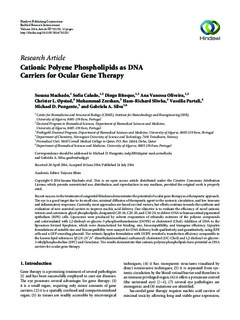| dc.contributor.author | Machado, Susana | |
| dc.contributor.author | Calado, Sofia | |
| dc.contributor.author | Bitoque, Diogo | |
| dc.contributor.author | Oliveira, Ana Vanessa | |
| dc.contributor.author | Øpstad, Christer Lorentz | |
| dc.contributor.author | Zeeshan, Muhammad | |
| dc.contributor.author | Sliwka, Hans-Richard | |
| dc.contributor.author | Partali, Vassilia | |
| dc.contributor.author | Pungente, Michael | |
| dc.contributor.author | Silva, Gabriela | |
| dc.date.accessioned | 2019-11-06T07:34:25Z | |
| dc.date.available | 2019-11-06T07:34:25Z | |
| dc.date.created | 2014-07-25T14:27:10Z | |
| dc.date.issued | 2014 | |
| dc.identifier.citation | BioMed Research International. 2014, 2014 . | nb_NO |
| dc.identifier.issn | 2314-6133 | |
| dc.identifier.uri | http://hdl.handle.net/11250/2626769 | |
| dc.description.abstract | Recent success in the treatment of congenital blindness demonstrates the potential of ocular gene therapy as a therapeutic approach. The eye is a good target due to its small size, minimal diffusion of therapeutic agent to the systemic circulation, and low immune and inflammatory responses. Currently, most approaches are based on viral vectors, but efforts continue towards the synthesis and evaluation of new nonviral carriers to improve nucleic acid delivery. Our objective is to evaluate the efficiency of novel cationic retinoic and carotenoic glycol phospholipids, designated C20-18, C20-20, and C30-20, to deliver DNA to human retinal pigmented epithelium (RPE) cells. Liposomes were produced by solvent evaporation of ethanolic mixtures of the polyene compounds and coformulated with 1,2-dioleoyl-sn-glycero-3-phosphoethanolamine (DOPE) or cholesterol (Chol). Addition of DNA to the liposomes formed lipoplexes, which were characterized for binding, size, biocompatibility, and transgene efficiency. Lipoplex formulations of suitable size and biocompatibility were assayed for DNA delivery, both qualitatively and quantitatively, using RPE cells and a GFP-encoding plasmid. The retinoic lipoplex formulation with DOPE revealed a transfection efficiency comparable to the known lipid references 3β-[N-(N′,N′-dimethylaminoethane)-carbamoyl]-cholesterol (DC-Chol) and 1,2-dioleoyl-sn-glycero-3-ethylphosphocholine (EPC) and GeneJuice. The results demonstrate that cationic polyene phospholipids have potential as DNA carriers for ocular gene therapy. | nb_NO |
| dc.language.iso | eng | nb_NO |
| dc.publisher | Hindawi | nb_NO |
| dc.rights | Navngivelse 4.0 Internasjonal | * |
| dc.rights.uri | http://creativecommons.org/licenses/by/4.0/deed.no | * |
| dc.title | Cationic polyene phospholipids as DNA carriers for ocular gene therapy | nb_NO |
| dc.type | Journal article | nb_NO |
| dc.type | Peer reviewed | nb_NO |
| dc.description.version | publishedVersion | nb_NO |
| dc.source.pagenumber | 13 | nb_NO |
| dc.source.volume | 2014 | nb_NO |
| dc.source.journal | BioMed Research International | nb_NO |
| dc.identifier.doi | 10.1155/2014/703253 | |
| dc.identifier.cristin | 1144383 | |
| dc.description.localcode | Copyright © 2014 Susana Machado et al. This is an open access article distributed under the Creative Commons Attribution License, which permits unrestricted use, distribution, and reproduction in any medium, provided the original work is properly cited. | nb_NO |
| cristin.unitcode | 194,66,25,0 | |
| cristin.unitname | Institutt for kjemi | |
| cristin.ispublished | true | |
| cristin.fulltext | original | |
| cristin.qualitycode | 1 | |

